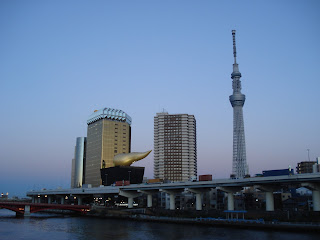Tokyo. For many, the mere name evokes images of the city of the future. Sleek, streamlined and bustling with tall towers, soaring overpasses and, crucially, people. Lots of people. In many ways, as the world's most populous metropolitan area and one of the most important economic centres, Tokyo is just that. But it's also a lot more. For me, it's also less.
Oddly, I never had an issue with the number of people. In fact, I barely noticed that the supposed overabundance of them (something about having previously braved the Hong Kong subway with all of my luggage at rush hour perhaps?).
 |
| Early morning tourists and Buddhist adherents at Senso-ji Temple in the 'old-style' Asakusa area. |
While I have a deep love for natural scenery and being out in nature (as evidenced by my many hiking-related blog posts), I also have quite a fondness for many of the world's biggest cities - New York, Rome and Istanbul rank pretty high up there for me, as do Cairo, Beijing and (much smaller) Toronto. Tokyo? Not so much. While there are many pockets of Tokyo that I really liked, and I definitely enjoyed being able to meet up with my friends that live there, the city just didn't do it for me overall. Perhaps it was just my mood, maybe I need to go back and try again, but for me, Tokyo was definitely my least favourite part of the trip. That having been said, I still had fun!
 |
| A woman selling traditional sticky rice-ball desserts in the quaint shopping street leading up to Senso-ji in Asakusa. |
As a natural product of being both so large and so populous, Tokyo isn't in possession of one single 'down town' or 'city centre'. Rather, it is more like a collection of several mini-cities, each with their own core. Sadly, sometimes the more generic cityscape holding these centres together seemed rather lifeless (Oddly, I found this to be particularly true of 'western' night district and mini-centre of a sort, Roppongi). These mini-cities often form pockets with their own unique feels. Many of these were delightful and quite fun to explore. Fortunately, Tokyo's public transit system (somewhat confusingly made up of train, bus and subway lines owned by several different companies) is quite well signed and very extensive, allowing travellers to get nearly everywhere given enough time (the city is huge!).
 |
| Looking toward the Tokyo Skytree (and delectable yet affordable internation food market underneath it) from accross the river in Asakusa. |
These two things in combination - the overwhelming flatness and unceasing array of buildings in every possible direction - that had me feeling claustrophobic after only my second day there (at which point I dashed off to get some skiing in before returning to see more).
Another contributing factor to my lack of love may have been that Tokyo feels too new and the archaeologist in me loves old things too much (after all, nearly all of the old-world cities I listed above have tended to combine both old and new, ancient and modern). This having been said, Tokyo is home to some wonderful museums (the Tokyo National Museum in Ueno is definitely worth a visit, and all my friends who have been rave about the National Museum of Emerging Science and Innovation in the Odaiba/Bay Area - they have working robots!) and it does still have one or two important 'cultural' sites - namely the Imperial Palace, which remains the formal residence of the Imperial Family even today, the old pleasure district in the Asakusa area and Meiji-jingu, or Meiji Shrine out in Harajuku (a district definitely worth visiting if only to check out the extraordinarily out-of-this-world outfits worn by many of the pre-teens parading through the ares). But none of these is truly old.
Although established in the Edo Era by the Tokugawa Shogunate, the current castle dates only to 1968; the shrine at Meiji-jingu, originally built in 1920, dates only to 1958; and the oldest of these sites, Senso-ji in Asakusa to the ancient date of 1950. All of this of course, is due to the bombings suffered by the area during WWII, which demolished much of the capital and ultimately allowed for the rise of the glinting metropolis as it is today. While, I might complain about the lack of 'old', the requirement to rebuild from scratch does seem to have lent Tokyo architects the room to build structures with some pretty funky architectural designs - and nowhere is this more evident than in the Odaiba-Tokyo Bay area, home to nerd paradise and one of the few places (apart from Tsukiji, the world's largest fish market) that remind you that Tokyo really is a port city (there is even a beach!).
 |
| The giant gundam in Odaiba. I cannot express how happy seeing this made me. |
Regardless of my feelings, Tokyo can't really be dismissed as a 'must see' in Japan, there is just too much there. I also have a suspicion that, much like London (which I also disliked on first glance but gradually grew to appreciate), Tokyo is a place that grows on you as you discover more and more about it. After all, in a place that big, there must be something for everyone (well... maybe not hikers ;) ).







No comments:
Post a Comment